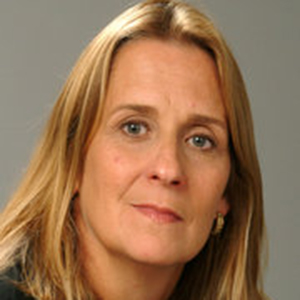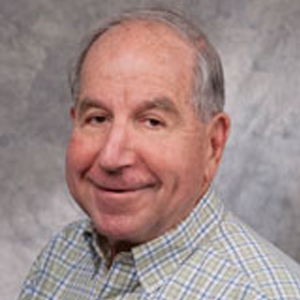Mary Jane Osborn (1927 – 2019)
Mary Jane Osborn, a prominent biomedical scientist, a trailblazer for women in science, and a former president of the American Society for Biochemistry and Molecular Biology, died Jan. 17 in Farmington, Connecticut. She was 91. The cause was complications following emergency surgery.
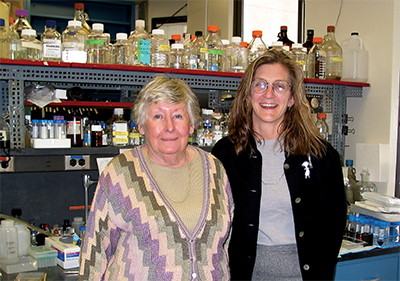 Mary Jane Osborn poses with her former Ph.D. student Inger Damon, who now directs the Division of High-Consequence Pathogens and Pathology in the Centers for Disease Control and Prevention’s National Center for Emerging and Zoonotic Infectious Diseases and is a captain in the U.S. Public Health Service. ALL PHOTOS courtesy OF sandra weller
Mary Jane Osborn poses with her former Ph.D. student Inger Damon, who now directs the Division of High-Consequence Pathogens and Pathology in the Centers for Disease Control and Prevention’s National Center for Emerging and Zoonotic Infectious Diseases and is a captain in the U.S. Public Health Service. ALL PHOTOS courtesy OF sandra weller
Osborn’s research career began in the late 1950s, a time when women were notoriously underrepresented in all fields of science and many major university biomedical research departments had no tenured female faculty. In the decades that followed, the number of female scientists in university departments increased significantly, although female faculty were (and continue to be) significantly underrepresented at the higher academic ranks. Although she always said she personally never felt she was professionally discriminated against, Osborn was keenly aware of the systemic problems faced by women in science. In recognition of this, the University of Connecticut Medical School, where she was a faculty member for 42 years, established the annual Osborn Lectureship in 2002 to celebrate women in science.
After hearing of Osborn’s death, Lucy Shapiro, director of the Beckman Center for Molecular and Genetic Medicine at Stanford University, said, “Mary’s breadth of knowledge, scientific rigor and acute intelligence would have made her a remarkable role model of any gender, but she was a woman in a world where few women had a chance to shine. And shine she did. When she spoke, people listened. When she published, her papers became the gold standard.”
Osborn made her first important scientific contribution in 1957 as a research fellow at the University of Washington, when she discovered the mechanism of action of the drug methotrexate, one of the earliest cancer chemotherapeutic agents. The research was published in the Journal of Biological Chemistry. Methotrexate also is widely used for patients with rheumatoid arthritis and psoriatic arthritis.
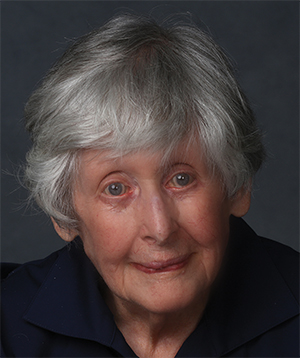 This photo of Mary Jane Osborn was taken for an Annual Review of Microbiology memoir she wrote recently. “It is very touching to me, as it shows frailty but also intense curiosity,” Sandra Weller said of the photo.As a faculty member at the New York University, Albert Einstein and University of Connecticut medical schools, she became a leader in studies of bacterial endotoxin (also known as lipopolysaccharide). This highly toxic molecule is located on the surfaces of a large group of bacteria that include the causative agents of life-threatening diseases such as typhoid fever and meningococcal meningitis. This work prompted her to confront a puzzling paradox — many cells are capable of fabricating very large complex molecules, such as endotoxin, that lie outside the cell body despite the fact that all of the building blocks and the energy sources required for their synthesis are inside the cell. Beginning in 1972, she used a combination of bacterial genetics, biochemistry and electron microscopy to solve key aspects of this problem. In her seminal 1972 JBC papers, she described the technique that made these experiments possible, now universally known as the Osborn method, which still is used in laboratories around the world.
This photo of Mary Jane Osborn was taken for an Annual Review of Microbiology memoir she wrote recently. “It is very touching to me, as it shows frailty but also intense curiosity,” Sandra Weller said of the photo.As a faculty member at the New York University, Albert Einstein and University of Connecticut medical schools, she became a leader in studies of bacterial endotoxin (also known as lipopolysaccharide). This highly toxic molecule is located on the surfaces of a large group of bacteria that include the causative agents of life-threatening diseases such as typhoid fever and meningococcal meningitis. This work prompted her to confront a puzzling paradox — many cells are capable of fabricating very large complex molecules, such as endotoxin, that lie outside the cell body despite the fact that all of the building blocks and the energy sources required for their synthesis are inside the cell. Beginning in 1972, she used a combination of bacterial genetics, biochemistry and electron microscopy to solve key aspects of this problem. In her seminal 1972 JBC papers, she described the technique that made these experiments possible, now universally known as the Osborn method, which still is used in laboratories around the world.
Her research gained her international renown, leading to her election to the American Academy of Arts and Sciences in 1977 and to the National Academy of Sciences in 1978, 10 years after assuming her first faculty position. She was the president of several important biomedical societies and the recipient of many honors and awards. In 1980, President Jimmy Carter appointed her to the National Science Board, the governing body of the National Science Foundation, the country’s major funder of basic scientific research.
Osborn served on the ASBMB Council from 1974 to 1975, and in 1981 she was elected ASBMB president, the second woman to hold that office.
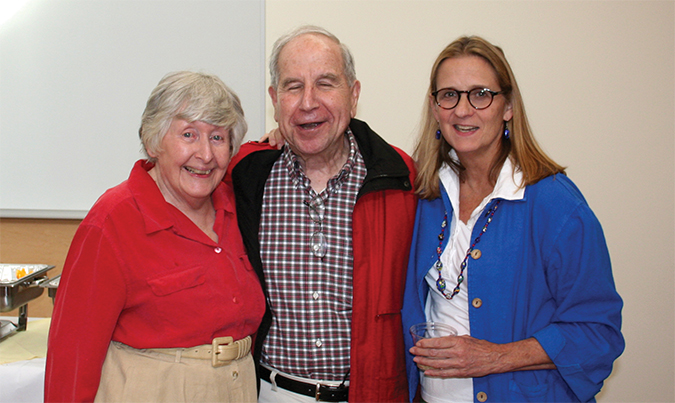 Mary Jane Osborn, Lawrence Rothfield and Sandra Weller pose together at a University of Connecticut departmental retreat in 2005.In the 1990s, she became interested in space science research. She chaired NASA’s Committee on Space Biology and Medicine, which produced a report that plotted the U.S. space biology research program in the first decade of the 21st century.
Mary Jane Osborn, Lawrence Rothfield and Sandra Weller pose together at a University of Connecticut departmental retreat in 2005.In the 1990s, she became interested in space science research. She chaired NASA’s Committee on Space Biology and Medicine, which produced a report that plotted the U.S. space biology research program in the first decade of the 21st century.
Osborn had a keen interest in poetry and the arts, and she traveled to New York City, often several times a month, to attend concerts and ballet and opera performances. She was a special fan of the Paul Taylor Dance Company, American Ballet Theater and New York City Ballet.
In 1968, she was one of the founding faculty who shaped the curriculum and character of the new medical school of the University of Connecticut in Farmington. She served as chair of the medical school’s department of microbiology from 1980 to 2002. She remained there as a professor of microbiology and of molecular biology and biophysics until her retirement in 2014.
Remembrances
These remembrances were written by scientists who worked with Mary Jane Osborn.
I had the privilege of doing my graduate work with Mary Jane in the early 1980s. As a young woman pursuing a career in research, I found her a brilliant scientist who always could ask the critical question and an outstanding role model. MJO treated all of us in her group (staff, students, postdocs and visiting scientists) as colleagues. She challenged us first and foremost to consider how the work we were proposing would advance the field, gave us the freedom to pursue our own ideas and encouraged us to persevere.
In 1982, Mary Jane was selected to give a Harvey lecture. It’s a tremendous honor to be chosen to give this lecture, and the whole lab drove to New York to hear her present “Biogenesis of the outer membrane of Salmonella.” I knew MJO would give a wonderful talk, that was a given, but I honestly will never forget that night. Our group arrived and sat together. We watched as the Harvey Society members in their formal attire filed into the theaterlike hall, and then Mary Jane was introduced. From the moment she took the podium, she owned the room, expertly presenting an amazing body of work. There could be absolutely no doubt she had truly advanced the field. I returned to the lab both tremendously proud to be part of her group and inspired to continue my studies.
By 1991 MJO was one of the 10 most cited women in science, a clear testament to the scientific excellence and importance of her work. As her student I had watched her spend numerous hours in service to scientific societies as an editor for several journals, to NIH reviewing grants for the molecular biology study section, and later serving as a member of the National Advisory General Medical Sciences Council, NIGMS. It was clear she felt it an honor to be asked to serve. The value she placed on this service influenced my own career path, eventually leading me away from the bench and into science administration.
Beyond the bench, Mary Jane was a wonderful cook, loved to garden and was a generous mentor. When her frozen chocolate mousse cake became the talk of the department, I asked her for the recipe and without hesitation she wrote it out for me. It’s still one of my favorite desserts to make! In spring her office windows would fill up with her newly potted cuttings, which eventually would find homes across the department; and over the years when I would call for advice or drop in to show a young nephew the lab I used to work in, she always made time to catch up.
Mary Jane was a true thought leader and the consummate academic researcher who served her scientific community with tremendous grace and goodwill. I will always be grateful to her for the privilege of being a member of her laboratory and for her mentorship.
— Pamela A. Marino
Chief, Biochemistry and Bio-related Chemistry Branch
Division of Pharmacology, Physiology and Biological Chemistry
National Institute of General Medicine Sciences
Mary Jane Osborn was a professor in the department of microbiology at UConn Health Center when I arrived as an assistant professor in 1975. I knew she was an amazing scientist, a reputation that was confirmed when she discussed her work in the department and by her remarkably insightful questions; at every seminar, on any topic, she always asked the best question.
At first, my lab was right across the hall from Mary’s operation. I was a bit scientifically lonely, having moved from a large lab as a postdoctoral fellow to a new department where it was just me and a technician. Fortunately, I quickly learned that I was always welcome to join Mary at the blackboard outside her lab or in her office. She was never too busy to listen to my latest experiment or idea and then explore it with me. I always left the blackboard or her office with great advice and new ideas. My focus on DNA tumor viruses was unrelated to Mary’s interests, but she generously shared her time to mentor a young colleague.
I want to share one incident. Mary had a lab full of talented trainees, and I came to know and have very high regard for one of her postdoctoral fellows. He was talented and accomplished, we enjoyed talking science and we eventually became interested in the possibility that he might work for a time in my lab. When I told her about our discussion, Mary responded that I’d be very lucky to have him in my lab, and she’d be supportive of whatever he decided. So one evening we took the plunge and moved him and his desk across the hall from Mary’s large lab to my mostly empty real estate. I was nervous to meet Mary the next morning, even though we had clearance. I saw her in the hall. She gave me a stern look and then said, “Bring back the desk!” Through the years, I’ve often reflected that it was not at all in her interest to lose a productive postdoc, but she never let me know it. Nick Jones did great things in her lab, in my lab and then in his own lab on both sides of the Atlantic.
Mary made a huge difference to me at the start of my career. She shared her incredibly insightful advice and a warm, welcoming friendship. I’ve been fortunate to count her as a friend for life. Thank you for everything, Mary!
— Thomas Shenk
James A. Elkins Jr. Professor of Life Sciences
Department of Molecular Biology
Princeton University
Mary Jane Osborn was an inspiration for me not only for her pioneering studies but also for her wisdom, advice and encouragement. Her work established that what we now know as the outer membrane of Gram-negative bacteria is really a membrane and not an especially complex cell wall as had long been thought. She gave us major insights not only into how lipopolysaccharide is made but also how lipopolysaccharide and phospholipids are transported to this membrane, which is located on the other side of the cell wall.
Her influence is such that in my current research seminar I show slides of two of her papers. Despite the fact that both of these were published in the 1970s, they remain very relevant. One of these describes the Osborn method for purifying the outer membrane. In this paper she notes that all of the components of the outer membrane are made inside the cell, and therefore mechanisms that transport these components across the cell envelope to the cell surface must exist. I have spent the better part of my career trying to understand these mechanisms.
How phospholipids are transported to the outer membrane remains a mystery. The second paper of Mary’s that I cite provides solid evidence that diffusional flow rapidly equilibrates phospholipids between the inner and outer membranes. We recently have identified a mutant in which this diffusional flow can be conditionally controlled, and we hope to use it to probe the elusive mechanism of phospholipid transport.
I know that Mary Jane was one of my strongest supporters, and I’m grateful for all she did for me. I communicated with her last in the early summer last year. She told me that she was writing a memoir for the Annual Review of Microbiology, and she requested a couple references from me. Thankfully, she did finish this memoir. She also invited me to stop by her home on the way to or from a Gordon Conference. I did not attend a meeting in New England last year and sadly missed this opportunity. I will miss her.
— Thomas J. Silhavy
Warner−Labert Parke−Davis Professor
Department of Molecular Biology
Princeton University
Audio interview and seminal papers
Audio interview
In a 2011 National Academy of Sciences interview, Mary Jane Osborn talks about her childhood journey to California and her early interest in science.
Seminal papers
Hatefi, Y., Osborn, M.J., et al. (1957). Hydroxymethyl tetrahydrofolic dehydrogenase.Journal of Biological Chemistry227(2), 637-47.
Osborn, M.J., et al. (1958). Inhibition of dihydrofolic reductase by aminopterin and amethopterin.Proceedings of the Society of Experimental Biological Medicine97(2), 429-31.
Osborn, M. J., et al. (1972). Mechanism of assembly of the outer membrane of Salmonella typhimurium. Site of synthesis of lipopolysaccharide.Journal of Biological Chemistry247(12), 3973-86.
Osborn, M.J., et al. (1972). Mechanism of assembly of the outer membrane of Salmonella typhimurium. Isolation and characterization of cytoplasmic and outer membrane.Journal of Biological Chemistry247(12), 3962-72.
Enjoy reading ASBMB Today?
Become a member to receive the print edition monthly and the digital edition weekly.
Learn moreGet the latest from ASBMB Today
Enter your email address, and we’ll send you a weekly email with recent articles, interviews and more.
Latest in People
People highlights or most popular articles
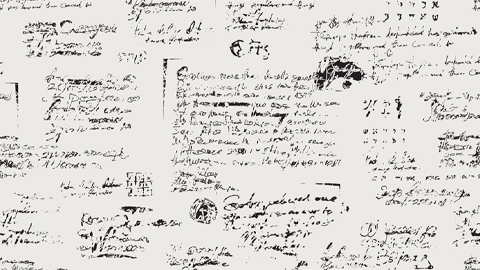
Notebook scribbles to synthesis pathways
The discipline Kendrick Smith learned as a musician helps him stay focused at the bench.
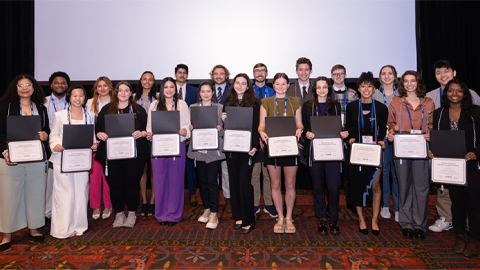
ASBMB inducts new honor society members
Chi Omega Lambda, which recognizes exceptional juniors and seniors pursuing degrees in the molecular life sciences, has 31 inductees in 2024.

2024 voter guide
Learn about the candidates running for ASBMB Council, Nominating Committee, Publications Committee and treasurer.

Charles O. Rock (1949 – 2023)
Colleagues and trainees remember a world expert in membrane lipid homeostasis.

Honors for Clemons, Hatzios and Wiemer
Awards, honors, milestones and more. Find out what's happening in the lives of ASBMB members.

Touching the future from the bench
Scholar, scientist, teacher and mentor Odutayo Odunuga discusses the important roles of the institutional PI, his journey and his research.

